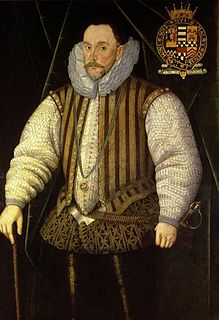Valence or valency may refer to:

William Marshal, 1st Earl of Pembroke, also called William the Marshal, was an Anglo-Norman soldier and statesman. He served five English kings—Henry II, his sons the "Young King" Henry, Richard I, and John, and finally John's son Henry III.

The Earldom of Pembroke is a title in the Peerage of England that was first created in the 12th century by King Stephen of England. The title, which is associated with Pembroke, Pembrokeshire in West Wales, has been recreated ten times from its original inception. Due to the number of creations of the Earldom, the original seat of Pembroke Castle is no longer attached to the title.

Pembroke Castle is a medieval castle in the centre of Pembroke, Pembrokeshire in Wales. The castle was the original family seat of the Earldom of Pembroke. A Grade I listed building since 1951, it underwent major restoration during the early 20th century.

Earl Marshal is a hereditary royal officeholder and chivalric title under the sovereign of the United Kingdom used in England. He is the eighth of the Great Officers of State in the United Kingdom, ranking beneath the Lord High Constable and above the Lord High Admiral. The Dukes of Norfolk have held the office since 1672.

The title Earl of Montgomery was created in the Peerage of England in 1605 for Sir Philip Herbert, younger son of the 2nd Earl of Pembroke. The first Earl inherited the Earldom of Pembroke in 1630 from his brother, the 3rd Earl, and the two titles remain united.

Earl of Carnarvon is a title that has been created three times in British history. The current holder is George Herbert, 8th Earl of Carnarvon. The town and county in Wales to which the title refers are historically spelled Caernarfon, having been Anglicised to Carnarvon or Caernarvon. The traditional Welsh spelling is itself a modified form of the original name of antiquity, Caer-yn-Arfon, meaning fortification opposite the island of Mona.

Earl Cawdor, of Castlemartin in the County of Pembroke, is a title in the Peerage of the United Kingdom. It was created in 1827 for John Campbell, 2nd Baron Cawdor.

Henry Herbert, 2nd Earl of PembrokeKG was a Welsh nobleman, peer and politician of the Elizabethan era.
William Alexander Sidney Herbert, 18th Earl of Pembroke, 15th Earl of Montgomery is an English peer. He became earl in 2003 following the death of his father, Henry Herbert, 17th Earl of Pembroke.

Philip Herbert, 4th Earl of Pembroke and 1st Earl of Montgomery, was an English courtier, nobleman, and politician active during the reigns of James I and Charles I. Philip and his older brother William were the 'incomparable pair of brethren' to whom the First Folio of Shakespeare's collected works was dedicated in 1623.

William Herbert, 3rd Earl of Pembroke, of Wilton House in Wiltshire, was an English nobleman, politician and courtier. He served as Chancellor of the University of Oxford and together with King James I founded Pembroke College, Oxford. In 1608 he was appointed Warden of the Forest of Dean, Constable of St Briavels Castle, Gloucestershire, and in 1609 Governor of Portsmouth, all of which offices he retained until his death. He served as Lord Chamberlain from 1615 to 1625. In 1623 the First Folio of Shakespeare's plays was dedicated to him and his brother and successor Philip Herbert, 1st Earl of Montgomery.

John Hastings, 2nd Earl of Pembroke,, was a fourteenth-century English nobleman and soldier. He also held the titles Baron Abergavenny and Lord of Wexford. He was born in Sutton Valence, the son of Laurence Hastings, 1st Earl of Pembroke, and Agnes Mortimer. His father died when John Hastings was a year old, and he became a ward of King Edward III while remaining in his mother's care. The King arranged for John to marry Edward's daughter Margaret in 1359, which drew John into the royal family. However, Margaret died two years later. John Hastings inherited his father's earldom, subsidiary titles and estates in 1368. The same year he made a second marriage, to Anne, daughter of Walter, Lord Mauny. The following year Pembroke began the career in royal service that was to continue for the rest of his life.
William Herbert may refer to:
Reginald Herbert, 15th Earl of Pembroke and 12th Earl of Montgomery was a British peer. His parents were Sidney Herbert, 14th Earl of Pembroke and Beatrix Louisa Lambton, daughter of George Lambton, 2nd Earl of Durham. He descended from a Russian aristocratic family, the Woronzows, through the marriage of Catherine Woronzow to George Augustus Herbert, 11th Earl of Pembroke. Catherine's father, Count Semyon Vorontsov, the Russian ambassador to Britain, brought the family to London in 1785.

Greenwich armour is the plate armour in a distinctively English style produced by the Royal Almain Armoury founded by Henry VIII in 1511 in Greenwich near London, which continued until the English Civil War. The armoury was formed by imported master armourers hired by Henry VIII, initially including some from Italy and Flanders, as well as the Germans who dominated during most of the 16th century. The most notable head armourer of the Greenwich workshop was Jacob Halder, who was master workman of the armoury from 1576 to 1607. This was the peak period of the armoury's production and it coincided with the elaborately gilded and sometimes coloured decorated styles of late Tudor England.
Earl of Wexford is an English or Irish peerage, and may refer to:

The Earl of Pembroke’s Armour is one of the pieces in the Royal Ontario Museum’s European Collection. This suit of armour belonged to the Earl of Pembroke, William Herbert (1501-1570).










